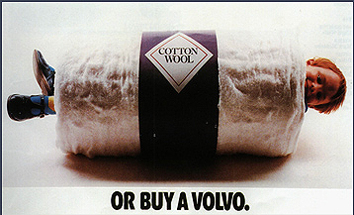 |
|
Written by ZOOZ
consulting and training | (972)-9-9585085 | [email protected]
| www.zooz.co.il
|
| Issue 74 |
Hello!
We are pleased to send you the new issue of
LaZOOZ
.
This monthly newsletter is sent as a free service to
thousands of senior executives.
It does not include advertisements, and features different
sections each time.
We have tried to
keep it brief, knowing that your time is precious and your
work is plentiful. Those who wish to learn more can find
links to articles and sources of relevant information. We
hope that you will find the newsletter useful. We would be
happy to receive any
comments and suggestions.
Pleasant reading!
Ari Manor, CEO,
ZOOZ
|
|
Innovation
Methods and tools for managing innovation
processes
|
Six Thinking Hats Ė Red Hat
Six Thinking Hats is a
method that facilitates a civilized and in-depth
discussion and comprehensive mapping of complex and
controversial ideas. The method was developed by Edward
de Bono, and it is detailed in
this book
. According to the method,
complex ideas must be examined using six different types
of thinking. Each type of thinking is represented by a
different-colored hat.
The first hat, and perhaps
the most important of them all, is the red hat. This hat is
recommended for the beginning of the discussion, and it
represents emotional thinking: gut feelings, emotions,
intuition. When participants use the red hat, they are asked
to describe briefly, and without justifying, how they feel
about the topic under discussion. Itís important to express
emotion, and not judgment.
For example:
-
The topic under discussion: Moving the
companyís production to China
-
Red hat: How
do you feel about this idea
Mitch:
I love it
Sarah:
I like it but itís concerning
Mitch:
I love it
Sarah:
I like it but itís concerning
Harry:
The idea scares me
Seth:
Confused
Rachel:
Itís exciting
Bob:
I hate the idea
Zoe:
Itís a terrible ide
a...
Discussion facilitator:
Zoe, ďa terrible ideaĒ is a judgment. We donít judge
with a red hat. Try again Ė How do you feel about
the idea?
Zoe:
Despise it
Facilitator:
To sum up, the idea is controversial, some of you
like it, others hate it, and some are confused.
Letís hash it out now using other hats.
People are not accustomed to
expressing their feelings during business discussions. Itís
not a legitimate thing, particularly at work. We are
required to make rational decisions and emotion is not
logical, itís not based on reason. However, emotion is the
eventual decisive factor. Therefore, acknowledging emotion
as a driving force and legitimizing its expression is very
important to fruitful discussions.
Evoking emotions, briefly and
without justifications, at the initial stages of the
discussion gives an indication of where people stand. In the
above example, after one or two minutes we knew who was for
the idea and who was against it, and without wasting time on
unnecessary and tiresome arguments. Also, by using the red
hat, the controversial nature of the topic was revealed,
proving that it needs to be discussed more at length. Had
all the participants loved the idea, it would have been
paramount to check what problems there were (that the staff
might miss because of the enthusiasm). Had the majority of
participants hated the idea, the idea might be outright
disqualified because of the anticipated difficulties of
implementing it in the organization. Why waste time and
money in continuing to discuss it?
In addition, the red hat
gives people an outlet for their feelings. Every participant
expresses his initial emotion, and then, after everyone has
expressed their own feelings, the group can continue to
explore additional aspects of the idea. If participants had
not been given an opportunity to express their feelings
about moving production to China in the above example, they
would have had to keep their emotions bottled up inside,
which would have manifested indirectly throughout the entire
discussion, jeopardizing the teamwork.
Finally, since the red hat is
based on emotion and not on judgment, it enables a much
greater degree of flexibility later in the discussion. The
participants can change their feelings later on. The
fluctuating nature of emotions is a known and acceptable
phenomenon. In contrast, judgment is fixed, prevents
flexibility, and it is more difficult to change. In our
example, Zoe might despise the idea, and later, after
learning more about it during the discussion, feel that she
despises the idea less than before, and perhaps is even
starting to like it. However, if Zoe claims that the idea
was terrible (meaning, judges it decisively), it will be
difficult for her to admit later on that it was a good idea
because it will be akin to admitting that her logic is
impaired, that her judgment is flawed (that she ďisnít
smartĒ).
In summary: The red
hat gives legitimacy to emotion, enabling a quick mapping of
where people stand, and preps participants for a more
comprehensive discussion. We will describe additional hats
in future editions of this column.
-
A
recommendation
for a book on leading changes processes
can be found
here
.
-
Additional
articles on Systematic Innovation
can be found
here
.
-
Information about
Systematic Innovation
can be
found
here
.
|
| |
|
|
move
What's new at ZOOZ
|
Strengthening Patents
Patent registration is an essential part of creating
intellectual property, and it is recommended for every
company that develops its own knowledge and technology, as
explained in
this article
,
which featured in a past edition of this column. If you know
this, and have already registered patents, you are most
probably using the services of a patent attorney to
check whether your idea is innovative and can be registered,
and to register it properly and submit it for registration
at patent offices worldwide.
However, itís important that you know that your patent
attorney is not a technology advisor. Perhaps he has
a relevant professional education (such as a degree in
Mechanical Engineering or Electronic Engineering), but his
expertise is in submitting your idea for registration, and
not in developing technological innovations. In order to
expand and strengthen your patent from a technological
perspective, you need a different type of consultant Ė a
technology advisor
.
Now youíre definitely wondering: Isnít technological
innovation development what our R&D Department does? And why
do we even need to strengthen our patent? And how can an
external advisor that isnít an expert in our industry give
us advice?
True, your R&D Department is meant to propose ideas for
technological innovation in your industry, but these ideas
need to be reinforced by adding additional technological
ideas (claims) to ensure that you can register a strong
patent, one that your competitors will have a hard time
bypassing. Assuming that you are interested in attaining a
true competitive advantage and exclusivity for the
technology you are developing, itís imperative that you have
strong patents. Unfortunately, the technological expertise
of your R&D Department, and the legal expertise of your
patent attorney, are generally insufficient for this
purpose.
In order to ensure truly strong patents, you require
a different type of advice: experts that can advise even
you, in your specific technological field, and help you
develop stronger technologies and patents. To make such
advice available, several months ago ZOOZ started
representing the American company Ideation in Israel,
whose consultants are considered the best technological
thinking team in the world.
All of Ideationís scientists have advanced degrees and
dozens of years of experience solving technological
problems, technological forecasting, strengthening patents
for clients such as Johnson & Johnson, Boeing, NASA, Xerox,
HP, Motorola, GM, Philips, 3M, and more. Ideation uses
designated computerized tools to systematically check how
claims can be added to create stronger patents, and to build
comprehensive patent walls that impart exclusivity and a
true competitive advantage.
Since Ideation has assisted some of the largest
multinational corporations in the world and smaller
companies in a wide variety of industries, they will be able
to help you as well. In addition, since they work with some
of the largest companies in the world, they will be able to
help you vis-à-vis such companies regarding intellectual
property and business development.
In recent months, Ideation conducted several patent
expansion and strengthening projects through us, and also
signed contracts with several knowledge centers of
universities and hospitals in Israel. The clients and we are
very pleased with the results, and you are welcome to
contact us
for recommendations. We also
welcome you to read about the work process with Ideation,
and the special rates being offered to Israeli customer,
here.
-
More information about Ideation
can be found
here
.
-
For information about recommendations,
contact us
.
|
|
|
Exposure
A creative
advertisement and its logic behind it
|
Not like that!
One of the more creative ways
to attract customersí attention is to offer them a
strange, unusual, and wacky solution to a problem that
you solve better.
This logic for creative advertising
is called the Absurd Alternative. It stresses that
there may be other (terrible) solutions, but if you want a
truly good solution, then itís best to use the one you
offer.
In this ad, the boy has been
wrapped in a wad of cotton wool to protect him during a
drive. This is of course an absurd solution to the problem
of road safety, but parents that come across this ad will
stop to look, read the text (Or buy a Volvo.), and
internalize the message: Buy a Volvo to protect your child.
The Absurd Alternative logic is
especially effective when evoking concerning issues that the
customers prefer to avoid thinking about, such as death,
disease, accidents, bankruptcy, dandruff, hemorrhoids, etc.
The more ridiculous and bizarre the solution presented in
the picture, the more attention grabbing it will be for
potential customers and cause them to evoke the problematic
issue (in this ad Ė accidents), grapple with it, and
consider the proposed solution (Volvo car).
- We would be happy to receive more interesting advertisements. Please send them to[email protected]
.
- Information about Creative Advertising workshops appearshere(page 18 of a Hebrew PDF booklet).
|
|
|


